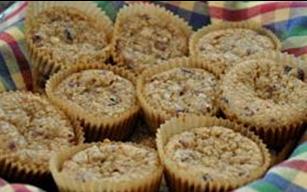Cranberry Quinoa Mini Muffins

Here is a muffin that is truly packed with fiber. Whole wheat flour and wholesome cooked quinoa combine with almonds and cranberries for a moist and delicious treat. Cooked quinoa can be used in place of some of the flour in almost any recipe to increase protein and fiber. Servings: 36
Here’s what you need:
- 1 cup unsweetened rice milk
- 1 Tablespoon ground flaxseeds
- 1/4 cup safflower oil
- 1/3 cup pure maple syrup
- 1/2 teaspoon vanilla extract
- 1/4 teaspoon almond extract
- zest from 1 small lemon
- 1 cup whole wheat flour
- 1/2 cup ground almonds
- 1 1/2 teaspoons baking powder
- 1/2 teaspoon freshly ground sea salt
- 1/2 teaspoon freshly ground cinnamon
- 1/2 teaspoon ground cardamom
- 1 1/4 cups cooked quinoa
- 1/3 cup finely chopped dried cranberries
- 1/4 cup organic turbinado raw cane sugar
Directions:
- Preheat oven to 370 degrees F. Place 12 muffins liners in muffin pan and set aside.
- In a medium sized bowl combine the rice milk, flaxseed, oil, maple syrup, vanilla, almond and lemon zest.
- In a separate bowl combine the flour, ground almond, baking powder, salt, cinnamon and cardamom. Mix the dry ingredients with the wet ones and fold in the cooked quinoa and chopped cranberries.
- Use an ice cream scooper to fill each muffin liner 3/4 full. Sprinkle the turbinado raw cane sugar on top of each muffin. Bake for 30 minutes or until golden.
Nutritional Analysis: One serving equals: 55 calories, 2.5g fat, 8g carbohydrate, 1g fiber, and 1g protein.
How Fast Is Your Metabolism?
March 8, 2011 by RobZ · Leave a Comment
A faster metabolism can…
 There’s a lot of talk about metabolism, and it seems that all the skinny folks have a large amount of it. But what exactly is metabolism, why is it important to your body, and what can you do to increase your metabolism? You’re about to find out!
There’s a lot of talk about metabolism, and it seems that all the skinny folks have a large amount of it. But what exactly is metabolism, why is it important to your body, and what can you do to increase your metabolism? You’re about to find out!
What Is Metabolism?
Inside your body, a complex process is going on that involves hormones, enzymes, and food. Known as metabolism, this process is responsible for your body’s ability to take food and turn it into energy. Additionally, your metabolism determines if you take that energy and burn it off with ease or if it sits around on your body and goes nowhere fast.
Though you probably wish your metabolism was sky high (everyone wants that sleek body – right?), there are a number of factors you can’t change that determine the level of your metabolism. These include age, sex, and your genes. That’s right – being over 40 decreases your metabolism, as does being a woman or having a family history of slow metabolism.
Why Is It Important?
Ever wondered why the first few pounds of weight loss come so easily for some people? It’s because your body has to work a little harder when you’re overweight. So when you make a small lifestyle change, your high metabolism does the rest, helping shed pounds with ease. Unfortunately, keeping a high metabolism isn’t after you’ve lost the initial few pounds. But if you want to lose weight and keep it off, you’ll need to have your metabolism working for you.
How Can I Boost It?
While there are a handful of factors that limit your ability to increase or decrease your metabolism, you can take your low metabolism by the horns and give it a boost with the right steps. Since you know that muscle burns more calories than fat, you probably already guessed the first step to speeding up your slow metabolism.
Get more muscles. A little flab here and there won’t make a huge difference, but muscle burns energy faster than flab. So if you want the highest possible metabolism, you’ll need to increase your muscle mass. Do this by exercising on a regular basis (three days a week at the least), and be sure to mix in plenty of weight lifting with your running, bicycling, and swimming. If you’re over 40 years of age, you may need some extra time in the gym, as you also have to fight your metabolism’s desire to slow down regardless of your routine.
Get five meals. Eating three times a day may be how you did things growing up, but unless you want to grow out, you’ve got to eat up more often. By substituting three large meals for five or more small meals throughout the day, you give your body confidence that there will be plenty of food coming later. This confidence allows your body to burn off more calories all day long.
Get good foods Eating five or six times a day will have the greatest impact on your metabolism if you’re filling up on the right stuff. That means tossing the extra slice of cake in the trash and going for a handful of carrots instead. Or grab some oatmeal for a fill up that will provide a slow-burning boost to your metabolic low.
Breakfast: The Crux of Metabolism
Think you can have a high metabolism without ever chowing down on breakfast foods? You’re wrong. Without eating breakfast, you put yourself at risk for slowed metabolism.
Here are a few ways skipping breakfast will do the body bad.
- It makes you hungrier at lunch and other times than you should be. When this happens, you don’t make good choices – and you know it!
- It gives you nothing to start with. When your stomach is empty, your body is doing everything possible to hang onto the calories at its disposal. Hence why you have no energy without breakfast!
- It starts you off all wrong. Start your day with a poor dietary decision, and you’re sure to make more of them throughout the day.
Garlic Asparagus
March 8, 2011 by RobZ · Leave a Comment
 Your diet should be filled with vegetables, with asparagus at the top of the list. This asparagus recipe is easy to make and tastes great. Serve it with a piece of white fish, chicken breast or other lean meat for a healthy meal. Servings: 4
Your diet should be filled with vegetables, with asparagus at the top of the list. This asparagus recipe is easy to make and tastes great. Serve it with a piece of white fish, chicken breast or other lean meat for a healthy meal. Servings: 4
Here’s what you need:
- 1 bunch asparagus
- 2 teaspoons olive oil
- 1 1/2 Tablespoons garlic, minced
- dash of salt and pepper
- 1 teaspoon lemon juice
- Preheat oven to 425 degrees F. Cut off the tough ends of the asparagus.
- In a casserole dish, combine the asparagus, oil, garlic, salt and pepper. Bake for 15-20 minutes, until tender.
- Remove from oven and mix in the lemon juice. Serve and enjoy!
Nutritional Analysis: One serving equals: 38 calories, 2g fat, 2g carbohydrate, 1g fiber, and 3g protein.






